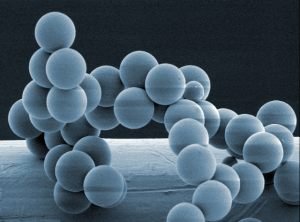Sep 11 2009
Aerosols influence both our climate and human health. They also open up new avenues for materials research, medicine, and pharmaceuticals. All these positive as well as negative aspects of suspended particles are in the focus of international experts currently attending the European Aerosol Conference at the KIT. On September 8, 2009, at 20 hrs, there will be a public lecture on Geo-Engineering, which discusses the controversial topic whether we could mitigate global warming by releasing large quantities of reflective particles.
 Finest dust particles on a filter fiber – visualized by an electron microscope. (Photo by: Institute for Mechanical Process Technology and Mechanics)
Finest dust particles on a filter fiber – visualized by an electron microscope. (Photo by: Institute for Mechanical Process Technology and Mechanics)
Fine particles suspended in air, referred to technically as aerosols, have a far more complex effect on the global climate than the greenhouse gas CO2. Many types of particles reflect sunlight, thereby counteracting the greenhouse effect. This has in fact caused a slight cooling of congested industrial zones such as Northwestern Europe, the Northeastern US, or the Indian subcontinent. Soot, on the other hand, absorbs light and contributes to a warming of the atmosphere. Moreover, there are indirect effects of aerosols such as fog and cloud formation. The exact net effect of global particle emissions on the climate therefore is and remains a rather exciting and important research topic.
In addition, aerosol science extensively studies potential risks for human health due to the inhalation of fine dust or nanoparticles. But aerosol technology hold major promises as well, for instance in producing new materials with custom-taylored properties on the nanoscale, and in the development of new medical therapies.
The full spectrum of thes issue is covered by the 2009 European Aerosol Conference (EAC) held from 6 tp 11 September at the KIT. Nearly 800 researchers from arund the world are discussing the latest results of basic abd applied research ranging from aerosol formation in the atmosphere to nanotechnology. 270 oral presentations and 560 posters focus on the role of aerosols for the atmosphere, climate, and human health. An accompanying exhibition will present the latest aerosol measurement technology.
The interested public will be addressed on Tuesday night by the lecture on Geo-Engineering by Dr Rolf Müller, a leading aerosol expert from the Forschungszentrum Jülich. His talk will focus on the extent to which global warming may be mitigated by specific interventions in the atmosphere.
This annual meeting of the European Aerosol Association is the most important European conference on aerosol research. This year, it is organized by the German-based Society for Aerosol Research (GAeF) and hosted by Gerhard Kasper, professor of chemical engineering at the KIT. The conference program can be found under http://www.gaef.de/EAC2009/.